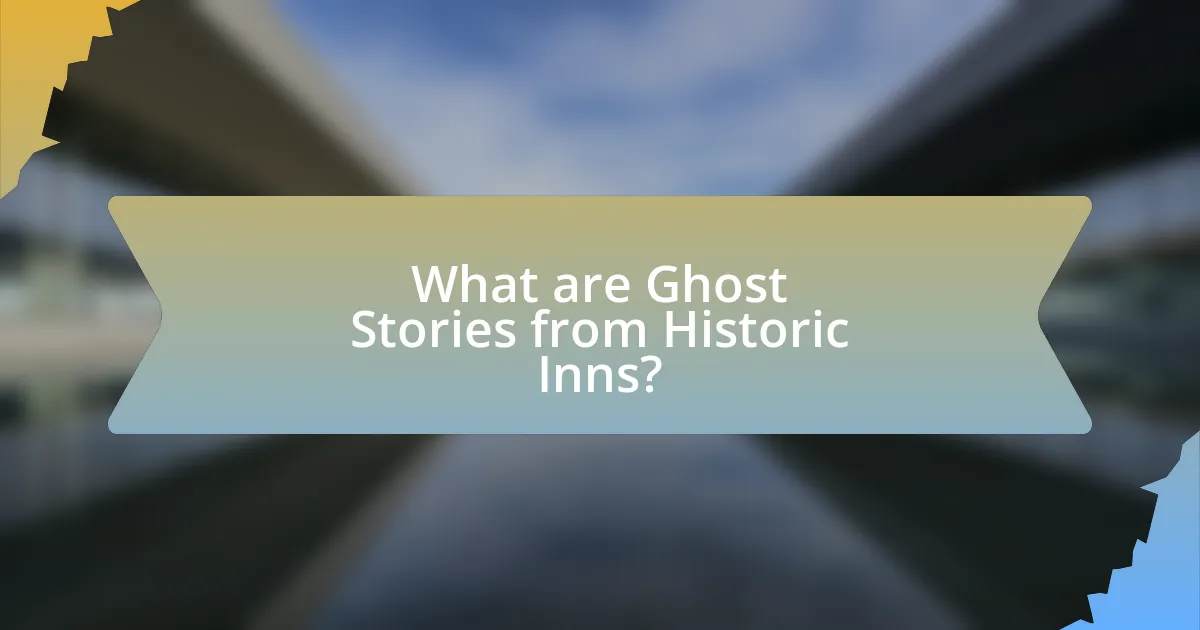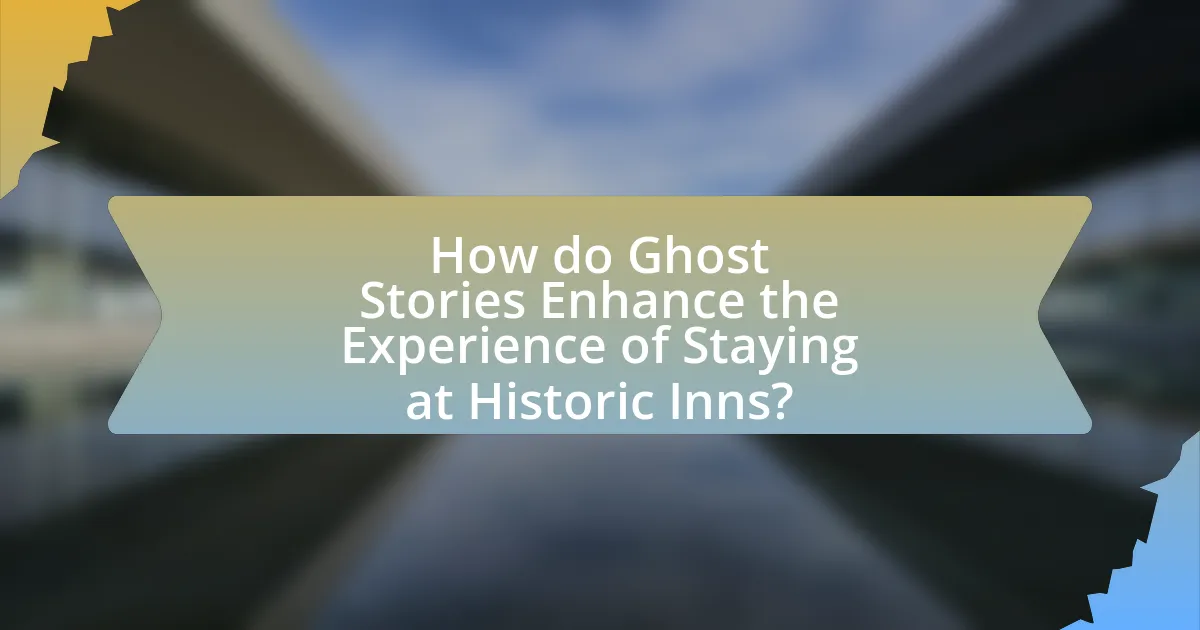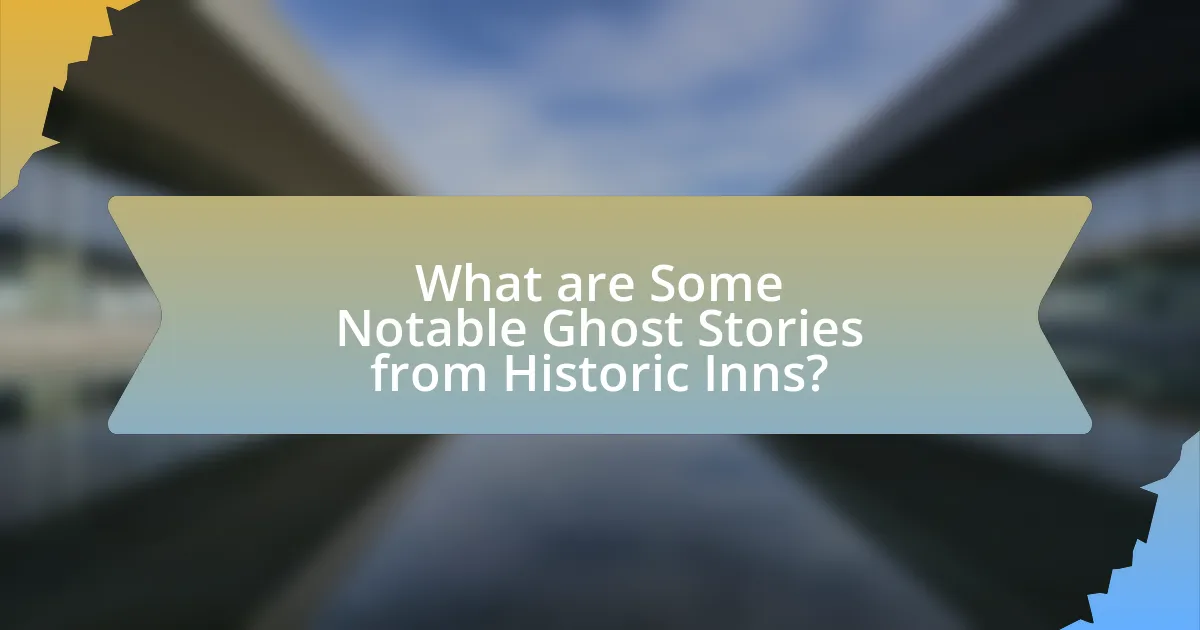Ghost stories from historic inns are accounts of paranormal experiences linked to the inns’ histories and former inhabitants, often involving sightings of apparitions and unexplained phenomena. These tales arise from significant historical events, such as battles and tragic deaths, which contribute to the belief that spirits linger in these locations. Local legends and folklore shape these narratives, enhancing their cultural relevance and appeal. The article explores notable haunted inns worldwide, the types of paranormal activities reported, and how ghost stories enhance the guest experience while influencing the marketing strategies of these accommodations. Additionally, it provides practical tips for travelers seeking to engage with the supernatural during their stays.

What are Ghost Stories from Historic Inns?
Ghost stories from historic inns are accounts of paranormal experiences reported by guests and staff, often linked to the inn’s history or former inhabitants. These stories typically include sightings of apparitions, unexplained noises, and other supernatural occurrences. For example, the Stanley Hotel in Colorado is famous for its ghostly encounters, including the spirit of its original owner, F.O. Stanley, who is said to roam the halls. Such tales contribute to the allure of these accommodations, attracting visitors interested in both history and the supernatural.
Why do historic inns have ghost stories associated with them?
Historic inns have ghost stories associated with them primarily due to their age and the significant events that have occurred within their walls. These establishments often have rich histories that include tales of tragedy, love, and conflict, which contribute to the belief that spirits may linger. For example, many historic inns were built during times of war or social upheaval, leading to deaths and unresolved issues that can manifest as ghostly encounters. Additionally, the tradition of storytelling in these settings helps perpetuate the legends, as guests share their experiences and local lore, further embedding the ghost stories into the cultural fabric of the inns.
What historical events contribute to the hauntings in these inns?
Historical events such as battles, tragic deaths, and significant social upheavals contribute to the hauntings in these inns. For instance, inns located near battlefields often report ghostly encounters linked to soldiers who perished during conflicts, such as the Civil War, where many soldiers sought refuge in local inns before or after battles. Additionally, tragic events like murders or untimely deaths within the inn premises can lead to lingering spirits; for example, the infamous case of a bride who died on her wedding day in a historic inn often results in sightings of her ghost. Furthermore, inns that served as hospitals during epidemics or wars frequently have reports of ghostly apparitions related to the suffering experienced by patients. These historical contexts provide a foundation for the supernatural experiences reported by guests and staff alike.
How do local legends and folklore shape the ghost stories?
Local legends and folklore significantly shape ghost stories by providing cultural context and thematic elements that resonate with the community’s history and beliefs. These narratives often incorporate local historical events, figures, or moral lessons, which enhance the authenticity and relatability of the ghost stories. For example, a ghost story about a haunted inn may stem from a local legend about a tragic event that occurred there, such as a shipwreck or a murder, thus intertwining the supernatural with the region’s historical narrative. This connection not only preserves the cultural heritage but also reinforces communal identity, as residents share and retell these stories, ensuring their continuity across generations.
What makes an inn considered ‘haunted’?
An inn is considered ‘haunted’ when it is reported to have paranormal activity, such as ghost sightings, unexplained noises, or other supernatural occurrences. These claims often stem from historical events associated with the inn, such as tragic deaths or significant happenings that leave a lingering presence. For instance, many inns that have been operating for centuries may have documented incidents of hauntings, supported by eyewitness accounts or folklore, which contribute to their reputation as haunted locations.
What types of paranormal activities are commonly reported?
Commonly reported types of paranormal activities include ghost sightings, unexplained noises, and physical disturbances. Ghost sightings often involve apparitions or shadowy figures, frequently described in historic inns where guests report feeling a presence. Unexplained noises, such as footsteps, whispers, or doors opening and closing, are also prevalent in these settings, often attributed to the spirits of former inhabitants. Physical disturbances, including objects moving or being misplaced, further contribute to the eerie atmosphere of these accommodations. These reports are documented in various accounts and studies, highlighting the enduring fascination with the supernatural in historic locations.
How do guests typically react to these ghostly encounters?
Guests typically react to ghostly encounters with a mix of fear, excitement, and curiosity. Many report feeling a heightened sense of adrenaline and thrill, often sharing stories of their experiences with fellow guests. Research indicates that approximately 30% of individuals who have experienced paranormal activity describe feelings of fear, while others express fascination and a desire to learn more about the history of the location. This duality in reactions highlights the complex emotional responses guests have when confronted with the supernatural in historic inns.
Where can you find the most famous haunted inns around the world?
The most famous haunted inns around the world can be found in locations such as the United States, the United Kingdom, and Ireland. Notable examples include the Stanley Hotel in Colorado, known for its connection to Stephen King’s “The Shining,” and the Olde Bell Inn in England, which dates back to the 12th century and is reputed to be haunted by several spirits. Additionally, the Shelbourne Hotel in Dublin is famous for its ghostly encounters, particularly with a former resident, Lord Edward Fitzgerald. These inns are recognized for their rich histories and numerous reported paranormal activities, making them popular destinations for ghost enthusiasts.
What regions are known for their haunted accommodations?
Regions known for their haunted accommodations include New England in the United States, particularly Massachusetts and Vermont, which are famous for historic inns like the Hawthorne Hotel and the Woodstock Inn. The United Kingdom, especially Scotland and England, features haunted locations such as the Ancient Ram Inn and the Edinburgh Vaults. Additionally, locations in Japan, such as the Aokigahara Forest near Mount Fuji, are associated with ghostly legends and accommodations. These regions have documented histories of paranormal activity, with numerous reports of ghost sightings and unexplained phenomena linked to their historic inns and hotels.
Which inns have the most compelling ghost stories?
The inns with the most compelling ghost stories include the Stanley Hotel in Colorado, known for its connection to Stephen King’s “The Shining,” where guests report sightings of the hotel’s original owner, F.O. Stanley. Another notable inn is the Myrtles Plantation in Louisiana, often referred to as one of America’s most haunted homes, where numerous ghostly encounters have been documented, including sightings of a former slave named Chloe. The Queen Mary in California, a retired ocean liner turned hotel, is famous for its ghostly apparitions and unexplained phenomena, with reports of spirits from its past. These inns are recognized for their rich histories and the numerous accounts of paranormal activity associated with them.

How do Ghost Stories Enhance the Experience of Staying at Historic Inns?
Ghost stories enhance the experience of staying at historic inns by creating an immersive atmosphere that captivates guests and deepens their connection to the location’s history. These narratives often stem from the rich past of the inns, where tales of hauntings and spectral encounters provide a unique context that engages visitors’ imaginations. For instance, inns like the Stanley Hotel in Colorado, known for its ghostly legends, attract guests seeking both comfort and a thrill, thereby increasing their overall enjoyment and interest in the historical significance of the place. Additionally, the presence of ghost stories can lead to increased social interaction among guests, as they share their own experiences or discuss the legends, fostering a sense of community and shared adventure.
What role do ghost stories play in attracting guests?
Ghost stories play a significant role in attracting guests to historic inns by enhancing the allure and uniqueness of the accommodations. These narratives create an atmosphere of intrigue and excitement, appealing to visitors’ curiosity about the supernatural. For instance, inns that promote their haunted history often report increased bookings, as guests seek immersive experiences that combine history with a thrill. Research indicates that establishments with ghost stories can see a rise in occupancy rates by up to 30%, as these tales differentiate them from standard lodging options. This phenomenon demonstrates that ghost stories not only enrich the guest experience but also serve as a strategic marketing tool for historic inns.
How do these stories influence the marketing of historic inns?
Ghost stories significantly influence the marketing of historic inns by enhancing their appeal and attracting a niche audience interested in the paranormal. These narratives create a unique selling proposition, differentiating the inns from standard accommodations. For instance, inns that promote their haunted history often report increased bookings, particularly around Halloween, as guests seek immersive experiences. According to a study by the University of California, Santa Barbara, themed tourism, including ghost tours and haunted accommodations, can increase visitor interest by up to 30%. This demonstrates that the allure of ghost stories not only enriches the guest experience but also drives revenue for historic inns.
What unique experiences do guests seek related to ghost stories?
Guests seek immersive and interactive experiences related to ghost stories, such as guided ghost tours, storytelling sessions, and paranormal investigations. These experiences allow guests to engage with the history and folklore of the accommodations, often featuring local legends and reported hauntings. For instance, historic inns often provide guests with opportunities to explore haunted locations, participate in ghost hunts using equipment like EMF detectors, and listen to firsthand accounts from staff or historians. Such activities enhance the thrill and curiosity surrounding the supernatural, making the stay memorable and unique.
How do inns incorporate ghost stories into their offerings?
Inns incorporate ghost stories into their offerings by creating themed experiences that attract guests interested in the paranormal. These establishments often host ghost tours, provide storytelling sessions, and offer special packages that include overnight stays in allegedly haunted rooms. For example, the Stanley Hotel in Colorado, known for its ghostly legends, offers ghost tours and has a dedicated “haunted” room that guests can book. This strategy not only enhances the guest experience but also leverages the historical significance and local folklore associated with the property, making it a unique selling point that draws visitors seeking both adventure and history.
What types of ghost tours or events are commonly held?
Common types of ghost tours or events include walking tours, haunted house experiences, and paranormal investigations. Walking tours typically guide participants through historic locations known for ghost sightings, often sharing local legends and folklore. Haunted house experiences are immersive events where participants explore themed environments designed to evoke fear and suspense, often featuring actors portraying ghosts or supernatural entities. Paranormal investigations involve participants using ghost-hunting equipment to explore reputedly haunted sites, often led by experienced investigators who provide insights into the history and reported hauntings of the location. These events are popular in areas with rich histories, such as New Orleans and Salem, where ghost stories are integral to local culture.
How do staff engage with guests regarding the ghost stories?
Staff engage with guests regarding ghost stories by sharing captivating narratives during check-in, guided tours, or special events. This interaction often includes recounting local legends and personal experiences to enhance the guests’ stay and create an immersive atmosphere. For instance, many historic inns have dedicated storytelling sessions where staff present well-researched tales that connect to the inn’s history, thereby enriching the guests’ understanding of the location’s haunted reputation.

What are Some Notable Ghost Stories from Historic Inns?
Some notable ghost stories from historic inns include the tale of the Ghost of the White Lady at the Langham Hotel in London, who is said to haunt the hallways after a tragic fall. Another example is the spirit of a former innkeeper at the Old Talbott Tavern in Bardstown, Kentucky, known for moving objects and appearing to guests. The Myrtles Plantation in Louisiana is famous for the ghost of Chloe, a former slave who is believed to roam the grounds, often seen wearing a green turban. These stories are supported by numerous eyewitness accounts and documented experiences from guests, reinforcing the haunted reputation of these historic inns.
What are the most famous ghost stories associated with specific inns?
The most famous ghost stories associated with specific inns include the tale of the Ghost of the White Lady at the Langham Hotel in London, known for sightings of a spectral woman in white. Another notable story is from the Stanley Hotel in Colorado, which inspired Stephen King’s “The Shining,” where guests report eerie sounds and ghostly apparitions. The Myrtles Plantation in Louisiana is infamous for the ghost of Chloe, a former slave, who is said to haunt the premises, often appearing in photographs. Lastly, the Old Talbott Tavern in Bardstown, Kentucky, is reputedly haunted by the spirit of a former patron who died in a bar fight, with reports of unexplained noises and sightings. These stories are well-documented through historical accounts and guest experiences, reinforcing their status as some of the most famous ghost tales linked to inns.
What is the story behind the haunted room at The Stanley Hotel?
The haunted room at The Stanley Hotel is Room 217, which is famously associated with the ghost of a former housekeeper named Elizabeth Wilson. In 1911, Wilson was involved in an accident when a gas leak caused an explosion in the room, leading to her injuries. Guests have reported various paranormal experiences in Room 217, including the sensation of being watched, objects moving on their own, and even the smell of lavender, which was a favorite scent of Wilson. The hotel’s connection to Stephen King’s novel “The Shining” further popularized its haunted reputation, as King stayed there in 1974 and was inspired by the eerie atmosphere.
How did the ghost of the Lady in White become a legend at The Myrtles Plantation?
The ghost of the Lady in White became a legend at The Myrtles Plantation due to a combination of tragic historical events and numerous reported sightings. The legend is primarily associated with a former slave named Chloe, who is said to have been involved in a love affair with the plantation owner, resulting in her tragic death. Over the years, visitors and staff have reported encounters with a ghostly figure dressed in white, believed to be Chloe, wandering the grounds and appearing in various rooms. These accounts, along with the plantation’s rich history of violence and loss, have solidified the Lady in White’s status as a haunting legend, attracting ghost hunters and tourists alike.
How do these stories vary across different cultures and regions?
Ghost stories from historic inns vary significantly across different cultures and regions, reflecting local beliefs, historical events, and societal values. For instance, in the United States, ghost stories often center around themes of tragic love or unresolved conflicts, influenced by the country’s diverse immigrant backgrounds and folklore traditions. In contrast, Japanese ghost stories, such as those involving yūrei, emphasize themes of vengeance and the afterlife, rooted in Shinto and Buddhist beliefs. Additionally, European ghost stories frequently incorporate historical figures or events, showcasing the region’s rich history and cultural heritage, such as the tales of haunted castles in the UK. These variations illustrate how cultural context shapes the narrative elements and moral lessons embedded in ghost stories, making them unique to their respective regions.
What unique cultural beliefs influence ghost stories in inns worldwide?
Unique cultural beliefs that influence ghost stories in inns worldwide include ancestral veneration, spiritualism, and local folklore. Ancestral veneration, prevalent in cultures such as those in Asia and Africa, often leads to stories of spirits returning to seek justice or communicate with the living. Spiritualism, particularly in Western cultures, fosters beliefs in the afterlife and the possibility of communication with spirits, which shapes narratives around haunted inns. Local folklore, rich with regional myths and legends, contributes to the unique characteristics of ghost stories, as seen in the tales of the Headless Horseman in American inns or the Yurei in Japanese accommodations. These beliefs are deeply rooted in the cultural history and practices of each region, providing a framework for the ghostly narratives that emerge in these settings.
How do local customs shape the narratives of hauntings?
Local customs significantly shape the narratives of hauntings by influencing the beliefs, practices, and storytelling traditions surrounding the supernatural. For instance, in cultures where ancestor veneration is prevalent, hauntings often involve spirits of deceased family members, reflecting the community’s values and respect for lineage. In contrast, regions with strong folklore traditions may feature unique ghostly figures tied to local legends, such as the Headless Horseman in Sleepy Hollow, which illustrates how specific customs and historical events inform the characteristics of hauntings. These narratives are further reinforced through local storytelling practices, festivals, and rituals that keep the legends alive, demonstrating the integral role of customs in shaping the perception and interpretation of hauntings.
What practical tips can travelers consider when visiting haunted inns?
Travelers visiting haunted inns should research the history and ghost stories associated with the location beforehand. Understanding the background can enhance the experience and prepare travelers for potential encounters. Additionally, it is advisable to book a room known for its paranormal activity, as these rooms often provide the most authentic experiences. Engaging with staff about their experiences can also offer insights and tips on the best times for ghost sightings. Lastly, bringing a camera or recording device can help capture any unexplained phenomena, as many guests report unusual occurrences.